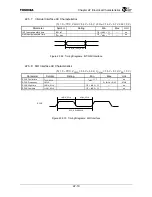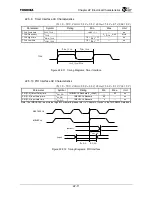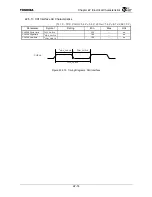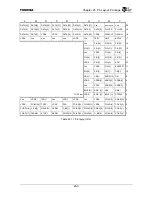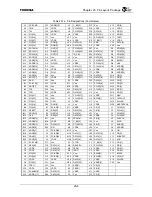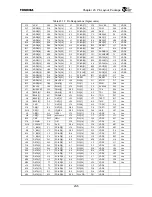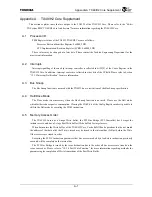
Chapter 24 Usage Notes
24-1
24. Usage
Notes
24.1 Limitation on DMA Data Chaining
•
Overview
The DMA Controller works incorrectly if the DMCCRn.IMMCHN bit is cleared and the address
increment value (DMSAIRn/DMDAIRn) is negative. The DMA Controller might also work
incorrectly regardless of the setting of the DMCCRn.IMMCHN bit if a dynamic or typical DMA
chaining is performed after completion of a transfer with a negative address increment.
•
Symptom
The DMA Controller might read wrong data or write data to wrong addresses.
•
Workaround Measure
Keep the DMCCRn.IMMCHN bit set. Make sure the DMSAIRn and DMDAIRn values for the
last descriptor are equal to or greater than 0 before adding the next command descriptor chain for
dynamic DMA chaining. For DMA data chaining with a negative address increment, write 0 or a
positive number once, then the desired negative increment value to the DMSAIRn/DMDAIRn.
24.2 Limitation on a Register Read After an SIO Software Reset
•
Overview
Immediately reading a register after a software reset (seting “1” to bit 15 of the SIFCRx
Register) results in the SIO not responding and the bus locking up.
•
Symptom
After a software reset (setting “1” to bit 15 of the SIFCRx Register), IMBUSCLK resets SIO for
four clock cycles. During this reset, the SIO does not recognize that it has been accessed even
when it has been accessed. The bus locks up since the device that accesses the SIO waits for a
response from the SIO. A bus error will then be issued if timeout errors have been enabled.
•
Workaround Measure
After the software reset, perform a dummy read operation to the register of a different module
on the IM-Bus, then access the SIO register. Performing the dummy access on the IM-Bus requires
eight IMBUSCLK cycles to complete, making it possible to avoid the problem since this is longer
than the amount of time the SIO reset requires.
24.3 Other
Precautions
•
Always set bit 4 in the G-Bus Arbiter Control register (GARBC) to 1. Clearing this bit might cause
arbitration deadlocks.
•
There are restrictions for address increment values regarding DMA burst transfers. For a detailed
description, see Section 8.3.7, “Single Address Transfer,” and Section 8.3.8, “Dual Address
Transfer.”
•
The four target address spaces (MEM0, MEM1, MEM2 and IO) of the PCI Controller may not
overlap. See Section 10.3.5, “Target Access.”
•
It is recommended to set the G2P Timeout register (GPTOCNT) to 0. See Section 10.4.12, “G2P
Timeout Count Register.”
Содержание TMPR4925
Страница 1: ...64 Bit TX System RISC TX49 Family TMPR4925 Rev 3 0 ...
Страница 4: ......
Страница 15: ...Handling Precautions ...
Страница 16: ......
Страница 18: ...1 Using Toshiba Semiconductors Safely 1 2 ...
Страница 40: ...3 General Safety Precautions and Usage Considerations 3 18 ...
Страница 42: ...4 Precautions and Usage Considerations 4 2 ...
Страница 43: ...TMPR4925 ...
Страница 44: ......
Страница 54: ...Chapter 1 Features 1 8 ...
Страница 58: ...Chapter 2 Block Diagram 2 4 ...
Страница 88: ...Chapter 4 Address Mapping 4 12 ...
Страница 226: ...Chapter 8 DMA Controller 8 58 ...
Страница 260: ...Chapter 9 SDRAM Controller 9 34 ...
Страница 480: ...Chapter 15 Interrupt Controller 15 32 ...
Страница 554: ...Chapter 19 Real Time Clock RTC 19 8 ...
Страница 555: ...Chapter 20 Removed 20 1 20 Removed ...
Страница 556: ...Chapter 20 Removed 20 2 ...
Страница 564: ...Chapter 21 Extended EJTAG Interface 21 8 ...
Страница 580: ...Chapter 22 Electrical Characteristics 22 16 ...
Страница 586: ...Chapter 23 Pin Layout Package 23 6 23 2 Package Package Type Package Code 256 pin PBGA PBGA 4L P BGA256 2727 1 27A4 ...
Страница 588: ...Chapter 24 Usage Notes 24 2 ...
Страница 590: ...Appendix A TX49 H2 Core Supplement A 2 ...


